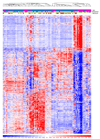Genome-wide analysis of aging and learning-related genes in the hippocampal dentate gyrus
- PMID: 18234529
- PMCID: PMC2530823
- DOI: 10.1016/j.nlm.2007.11.006
Genome-wide analysis of aging and learning-related genes in the hippocampal dentate gyrus
Abstract
We have previously described the transcriptional changes that occur in the hippocampal CA1 field of aged rats following a Morris Water Maze (MWM) training paradigm. In this report we proceed with the analysis of the dentate region from the same animals. Animals were first identified as age learning-impaired or age-superior learners when compared to young rats based on their performance in the MWM. Messenger RNA was isolated from the dentate gyrus of each animal to interrogate Affymetrix RAE 230A rat genome microarrays. Microarray profiling identified 1129 genes that were differentially expressed between aged and young rats as a result of aging, and independent of their behavioral training (p<0.005). We applied Ingenuity Pathway Analysis (IPA) algorithms to identify the significant biological processes underlying age-related changes in the dentate gyrus. The most significant functions, as calculated by IPA, included cell movement, cell growth and proliferation, nervous system development and function, cellular assembly and organization, cell morphology and cell death. These significant processes are consistent with age-related changes in neurogenesis, and the neurogenic markers were generally found to be downregulated in senescent animals. In addition, statistical analysis of the different experimental groups of aged animals recognized 85 genes (p<0.005) that were different in the dentate gyrus of aged rats that had learned the MWM when compared to learning impaired and a number of controls for stress, exercise and non-spatial learning. The list of learning-related genes expressed in the dentate adds to the set of genes we previously described in the CA1 region. This long list of genes constitutes a starting tool to elucidating the molecular pathways involved in learning and memory formation.
Figures







References
-
- Aitken DH, Meaney MJ. Temporally graded, age-related impairments in spatial memory in the rat. Neurobiol Aging. 1989;10(3):273–276. - PubMed
-
- Alfonso J, Pollevick GD, et al. Identification of genes regulated by chronic psychosocial stress and antidepressant treatment in the hippocampus. Eur J Neurosci. 2004;19(3):659–666. - PubMed
-
- Amat J, M-A P, Watkins LR, Maier SF. Escapable and inescapable stress differentially and selectively alter extracellular levels of 5-HT in the ventral hippocampus and dorsal periaqueductal gray of the rat. brain research. 1998;797(1):12–22. - PubMed
-
- Aloe L, Properzi F, et al. Learning abilities, NGF and BDNF brain levels in two lines of TNF-alpha transgenic mice, one characterized by neurological disorders, the other phenotypically normal. Brain Res. 1999;840(1–2):125–137. - PubMed
-
- Altman J, Das GD. Autoradiographic and histological evidence of postnatal hippocampal neurogenesis in rats. J Comp Neurol. 1965;124(3):319–335. - PubMed
Publication types
MeSH terms
Grants and funding
LinkOut - more resources
Full Text Sources
Medical
Molecular Biology Databases
Miscellaneous

